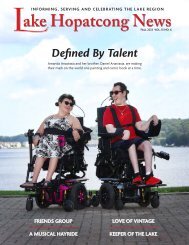You also want an ePaper? Increase the reach of your titles
YUMPU automatically turns print PDFs into web optimized ePapers that Google loves.
34<br />
HISTORY<br />
Lake Hopatcong’s<br />
Queen of the High Tower<br />
The Treaty of<br />
Versailles,<br />
which ended World<br />
War I, forbade Germany from stationing<br />
armed forces in a demilitarized zone known as<br />
the Rhineland, a region in western Germany<br />
bordering France, Belgium and part of the<br />
Netherlands. Although the agreement stated<br />
that Allied forces would occupy the region,<br />
German troops reoccupied the zone on March<br />
7, 1936, in a blatant violation of the treaty.<br />
Hitler gambled that the western powers<br />
would not intervene.<br />
His action brought condemnation from<br />
Great Britain and France, but neither nation<br />
intervened to enforce the treaty. At a point<br />
when German forces were still weak and could<br />
have been stopped, the world watched German<br />
aggression across eastern Europe until the<br />
invasion of Poland in 1939 shattered the idea<br />
that war could be avoided.<br />
Many parallels have been drawn recently<br />
between these events preceding World War<br />
II and Russia’s invasion of Ukraine. Another<br />
comparison between recent events and 1936 is<br />
the way news from Europe cast a foreboding<br />
shadow over an Olympic Games.<br />
Throughout the Winter Olympics in Beijing<br />
this past February, there were constant reports<br />
of an imminent Russian invasion of Ukraine.<br />
Most people could not conceive of the world<br />
again witnessing a land war in Europe. Yet<br />
Got leakys?<br />
by MARTY KANE<br />
Photos courtesy of the<br />
LAKE HOPATCONG<br />
HISTORICAL MUSEUM<br />
ARCHIVES<br />
LAKE HOPATCONG NEWS <strong>Memorial</strong> <strong>Day</strong> <strong>2022</strong><br />
Russian forces crossed the Ukrainian<br />
border just days after the Games<br />
ended.<br />
At Lake Hopatcong in the summer<br />
of 1936, many were focused on the<br />
upcoming Olympic Games in Berlin.<br />
Thousands of cheering, flag-waving<br />
spectators lined the New York and<br />
New Jersey shoreline on July 15 to see<br />
359 members of the U.S. Olympic<br />
team off for their 10-day journey to<br />
Germany.<br />
Among the 46 female team members<br />
was Cornelia “Corky” Gilissen, a<br />
20-year-old diver who had learned to<br />
swim at her family’s Lake Hopatcong<br />
cottage.<br />
In an Olympics that will forever be<br />
remembered for the dramatic politics being<br />
played out as a precursor to the devastating<br />
war ahead, the American team also featured the<br />
great Jesse Owens, who would win four gold<br />
medals in track and field, and a men’s rowing<br />
team made up of University of Washington<br />
college students who would manage an<br />
incredible David versus Goliath victory over a<br />
dominant German team in front of Hitler and<br />
Nazi officials.<br />
The Lake Hopatcong community eagerly<br />
followed the story of one of its own.<br />
Born on September 21, 1915, in Elmhurst,<br />
Queens, Gilissen began summering in the<br />
Northwood section of Hopatcong with her<br />
family around 1920.<br />
In a 1939 newspaper interview with the<br />
Rochester Democrat and Chronicle, Gilissen<br />
explained she learned to swim at Lake<br />
Hopatcong at the age of 6. Though their<br />
973-398-0875<br />
We’ll never ask how it happened!<br />
Cornelia Gilissen competing in the 1934<br />
Metropolitan AAU Swimming Meet at<br />
Jones Beach, Long Island.<br />
parents could not swim, Gilissen and her two<br />
younger sisters learned by daily practice in the<br />
lake.<br />
In July 1928, 12-year-old Gilissen caught<br />
the attention of the lake community by<br />
winning the girls’ “fancy diving” title (known<br />
today as springboard) at the Lake Hopatcong<br />
Association competition at Glasser’s Pavilion<br />
(now the location of Lola’s Mexican Restaurant).<br />
A year later the talented teen earned<br />
the interest of the entire American diving<br />
community when she competed in the annual<br />
Daily News Water Derby in New York City’s<br />
Central Park.<br />
A photograph in the August 2, 1929 Daily<br />
News of Gilissen in mid-flight during the<br />
Water Derby competition was captioned “as<br />
graceful and poised as a bird on the wing,<br />
Cornelia Gilissen, of Lake Hopatcong, N.J.,<br />
goes through one of her dives from the fourfoot<br />
board. She won third place in the event for<br />
girls and helped to thrill the crowd of 60,000.”<br />
Just one day earlier, Gilissen had earned two<br />
first-prize trophies at the Lake Hopatcong<br />
Yacht Club’s annual competition. Younger<br />
sister Josephine, a competitive swimmer, also<br />
took home a first-place trophy.<br />
Competing nationally while still finding the<br />
time to participate in diving, swimming and<br />
canoeing competitions at Lake Hopatcong was<br />
the norm for Corky Gilissen.<br />
In 1930, Gilissen began training and<br />
competing with the Women’s Swimming<br />
Association of New York. She moved up to<br />
a second-place finish in the Water Derby<br />
that year and in 1931 won the competition,<br />
establishing her as one the East Coast’s strongest

















